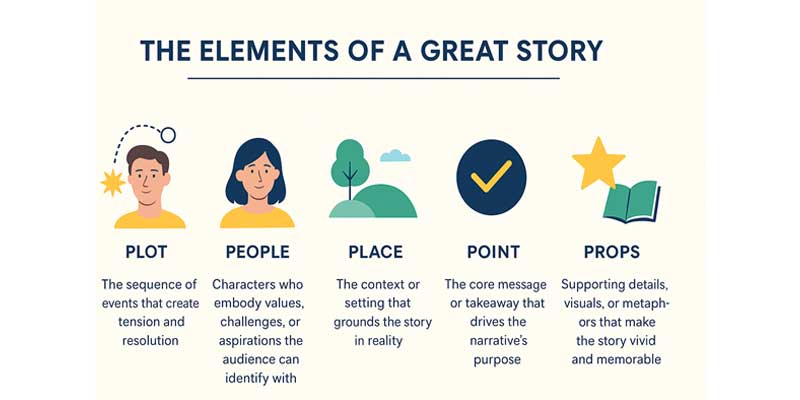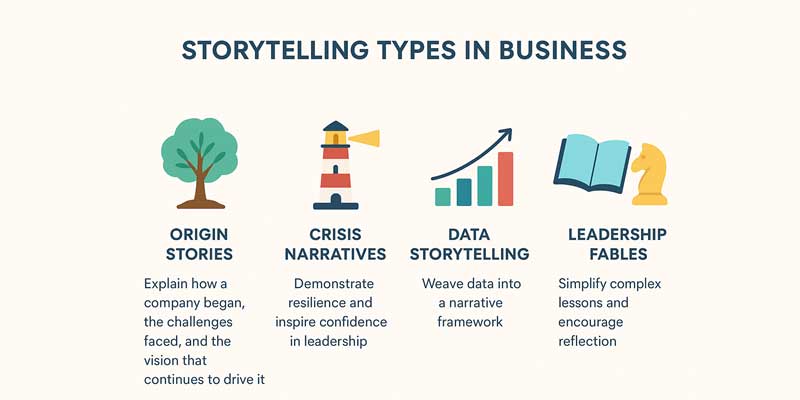

All modern businesses engage in continuous efforts to discover efficient relationship-building strategies aimed at their audience. The search for impactful business tools provides storytelling as one of the most powerful resources. The effectiveness of business storytelling derives from what factor precisely? Science shows how business storytelling works in an exceptional capability to engage audiences while persuading them and stimulating them to perform actions because of its neurological impact on brain functions.
Business storytelling is more than just weaving words into a narrative; it is a strategic approach to communication that transforms facts, data, and brand messages into stories that connect with people on an emotional level. According to insights from Berkeley Executive Education, storytelling in business is about creating meaning through narrative sense-making. Instead of presenting raw information, leaders and brands frame their ideas in a way that resonates with the audience’s values, experiences, and aspirations.
This method works because stories are one of the most effective tools humans have for understanding the world. While data and statistics may inform, stories inspire and persuade. MindTools emphasizes that storytelling organizes complex information into a structure that is easier for people to process and remember. A well-crafted story can simplify intricate concepts, making them both relatable and actionable.
Similarly, Wordtune highlights that storytelling bridges the gap between a business and its stakeholders by bringing in characters, emotions, and journeys that audiences can identify with. Whether it is the story of how a company was founded, the challenges it overcame, or the values it represents, these narratives humanize a brand and make it memorable.
In essence, business storytelling is not just about telling tales—it is about strategically shaping communication so that facts are transformed into compelling narratives that inspire trust, engagement, and action.
In a marketplace saturated with advertisements and information, facts alone rarely move people. Business storytelling brings a human element to communication by embedding emotion and relatability into brand messages. Instead of simply stating features or achievements, companies that tell stories about their journey, challenges, and values build stronger emotional bonds with their audience. This humanized approach fosters trust, as customers feel they are engaging with a brand that shares their aspirations and understands their struggles. Over time, these connections translate into deeper loyalty and advocacy, setting businesses apart from competitors who rely solely on data-driven communication.
Neuroscience research consistently shows that stories are more memorable than raw facts or figures. By framing information within a narrative, businesses make their messages easier to recall and repeat. A well-told story activates more areas of the brain, improving both comprehension and retention. This gives organizations a competitive edge: while facts may fade, stories linger in the minds of customers, employees, and partners. In a crowded market, a memorable story is often the deciding factor that differentiates one brand from another.
Beyond emotional resonance and memory, storytelling is a catalyst for action. As Investors.com highlights, the most powerful stories follow a structure—an engaging opening, a compelling body, and a satisfying ending—that stirs emotions and nudges audiences toward a desired outcome. When crafted with this structure, stories do more than entertain; they inspire audiences to act—whether that means adopting new ideas, purchasing a product, or embracing a brand’s mission. By tying messages to emotional triggers, businesses can motivate real-world behavior and create lasting impact.
A powerful business story is not just about what is told—it’s about how it is told. According to MindTools, a great story typically includes relatable characters, a clear conflict, and a resolution that delivers meaning. These elements draw the audience in, making them emotionally invested and more likely to connect with the underlying message.
Go Narrative adds further clarity with its “5 Ps” framework, a practical model that breaks down what makes stories resonate:

When businesses integrate these elements, they ensure their storytelling is not just entertaining but also purposeful, aligning with brand goals and audience needs.
Business storytelling can take many forms, each serving a distinct strategic function:
By understanding and applying these different story types, businesses can tailor their messaging to suit diverse contexts—from brand building to crisis management, from motivating employees to winning over customers.

Effective business storytelling is not accidental—it follows proven approaches that consistently resonate with audiences. Wordtune outlines five practical strategies that brands can apply across different contexts:
These approaches help businesses move beyond transactional messaging and into the realm of connection and influence.
Several brands and leaders have demonstrated the power of stories in shaping audience perception and loyalty:
These examples demonstrate that storytelling is not just a creative tactic but a strategic lever for persuasion, differentiation, and brand growth.
With the rise of generative AI, storytelling has entered a new era. Wordtune emphasizes that AI tools can assist businesses in:
Academic research also supports this evolution, with recent studies showing that AI-generated narratives can enhance marketing storytelling by blending creativity with data-driven precision. However, experts caution that authenticity should remain at the core—AI is a tool for amplification, not replacement.
When used thoughtfully, AI helps brands elevate their storytelling strategies, ensuring narratives are both emotionally engaging and contextually relevant.
Narratives about how and why a company began humanize the brand and establish authentic connections with audiences.
Stories that position the customer as the hero and your business as the guide or solution provider leverage the power of identification.
Narratives that communicate core company values through examples and anecdotes rather than abstract statements.
Stories structured around common customer pain points and their resolution create immediate relevance and engagement.
The core storytelling power that digital marketing agency uses in business has evolved extensively during recent years while maintaining its effectiveness through all marketing platforms and formats. Regardless of the medium, such as blogs or videos or social media, or websites, the neurological structures underlying story effectiveness operate consistently.
The process of measuring how business storytelling works belongs to the same scope as any business strategy understanding. Digital marketing solutions enable business tracking of user participation in addition to assessing emotional reactions and recalling processes, and sales conversions for narrative-based content.
Measures such as heat mapping, time-on-page examination, social sharing tracking, and comment sentiment analysis supply data about audience reactions to storytelling content. These performance indicators let developers enhance their storytelling methods over time to achieve maximum neurological and psychological results.
The foundation of every powerful business story lies in understanding the audience. Investors.com emphasizes that stories only resonate when they are tailored to the listeners’ needs, interests, and emotional triggers. Wordtune adds that identifying a clear purpose—whether it is to inspire, persuade, or educate—ensures the narrative remains focused. By mapping out who the audience is and what action you want them to take, you set the stage for stories that create genuine impact rather than generic messages.
A compelling story follows a structure that captures attention, sustains interest, and ends with clarity. Lida Citroën’s storytelling framework highlights three essential phases:
When brands use this structure, they move beyond fragmented messaging and instead deliver narratives that are persuasive, coherent, and memorable.
Stories resonate most when they are authentic. Pam Didner points out that using real testimonials and true customer experiences builds credibility, while Go Narrative underscores the importance of clarity and purpose. Sarah Wayte further stresses the use of visual elements—such as photos, videos, or infographics—to reinforce key messages and keep stories dynamic. By pairing authenticity with visual storytelling, businesses make their narratives both believable and engaging, ensuring they stand out in a noisy digital environment.
Storytelling is not a one-time activity but a continuous process of refinement. Measuring engagement—through metrics such as time on page, shares, or lead conversions—offers insights into what resonates. Using AI-powered tools, businesses can adjust tone, test different narrative variations, and refresh stories regularly to keep them aligned with audience expectations. Iteration ensures storytelling stays relevant and impactful over time.
While storytelling is powerful, it comes with challenges. As the New Yorker notes, narratives can sometimes oversimplify complex issues, creating biases or leaving out important details. Businesses should be mindful not to distort facts for the sake of a “neat” story.
Additionally, over-polished narratives may erode trust. Modern audiences, shaped by transparency demands, prefer what Vogue Business calls “radical honesty.” This means being open about both achievements and shortcomings, allowing brands to come across as authentic rather than staged. Striking this balance ensures that storytelling remains a tool for trust-building, not manipulation.
Business storytelling is more than a creative exercise—it is a strategic asset that builds trust, inspires action, and differentiates brands in competitive markets. By defining the audience, structuring stories for impact, prioritizing authenticity, and constantly iterating, organizations can turn storytelling into a long-term advantage.
As a next step, businesses should audit their current content: where can stories enhance clarity, inspire loyalty, or drive conversions? Start small—transform a case study into a customer journey or reframe a presentation into a narrative with a clear arc.
For readers looking to get started, consider downloading our Business Storytelling Template, designed to help you map out your brand stories step by step. With the right framework, storytelling becomes not just an art, but a repeatable strategy that drives results.